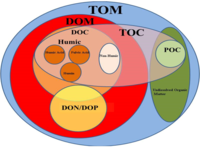
Systematic Review of the Clinical Outcomes of Iron Reduction in Hereditary Hemochromatosis
Sign Up to like & getrecommendations! Published in 2020 at "Hepatology"
DOI: 10.1002/hep.31405
Abstract: Hereditary Hemochromatosis is a condition caused by defects in iron-sensing genes leading to parenchymal iron loading. If diagnosed early and treated appropriately, many of the complications, including liver fibrosis, cirrhosis and liver cancer, arthritis, cardiomyopathy… read more here.
Keywords: reduction; systematic review; hereditary hemochromatosis; iron reduction ... See more keywords

Faster redox fluctuations can lead to higher iron reduction rates in humid forest soils
Sign Up to like & getrecommendations! Published in 2018 at "Biogeochemistry"
DOI: 10.1007/s10533-018-0427-0
Abstract: Iron (Fe) minerals play an important role in carbon (C) and nutrient dynamics in redox fluctuating soils. We explored how the frequency of redox oscillations influence Fe reduction rates and C content in Puerto Rican… read more here.
Keywords: reduction; redox fluctuations; iron reduction; oscillation ... See more keywords

Effects and mechanisms of modified biochars on microbial iron reduction of Geobacter sulfurreducens.
Sign Up to like & getrecommendations! Published in 2021 at "Chemosphere"
DOI: 10.1016/j.chemosphere.2021.130983
Abstract: Biochar was proved as an electron shuttle to facilitate extracellular electron transfer (EET) of electrochemically active bacteria (EAB); however, its underlying mechanism was not fully understood. In this study, we aimed to further explore how… read more here.
Keywords: reduction; iron reduction; geobacter sulfurreducens; modified biochars ... See more keywords

Abundant sediment organic matter potentially facilitates chemical iron reduction and surface water blackness in a Chinese deep lake.
Sign Up to like & getrecommendations! Published in 2020 at "Environmental pollution"
DOI: 10.1016/j.envpol.2020.116002
Abstract: Black bloom has become an increasingly severe environmental and ecological problem in lots of lakes. Ferrous monosulfide (FeS), which is closely related to chemical iron reduction (CIR), is considered the major cause for black water… read more here.
Keywords: surface water; reduction; iron reduction; water ... See more keywords

Predicted iron metabolism genes in hard ticks and their response to iron reduction in Dermacentor andersoni cells.
Sign Up to like & getrecommendations! Published in 2020 at "Ticks and tick-borne diseases"
DOI: 10.1016/j.ttbdis.2020.101584
Abstract: For most organisms, iron is an essential nutrient due to its role in fundamental cellular processes. Insufficient iron causes sub-optimal metabolism with potential effects on viability, while high levels of iron are toxic due to… read more here.
Keywords: response; iron metabolism; metabolism; iron reduction ... See more keywords

Graphite accelerate dissimilatory iron reduction and vivianite crystal enlargement.
Sign Up to like & getrecommendations! Published in 2020 at "Water research"
DOI: 10.1016/j.watres.2020.116663
Abstract: Biomineralized vivianite induced by dissimilatory iron reduction bacteria (DIRB) has received increasing attention because it alleviates phosphorus crisis and phosphorus pollution simultaneously. However, the relatively small crystal size and low Fe(III) reduction rate restrict the… read more here.
Keywords: reduction; iron reduction; dissimilatory iron; iron ... See more keywords

The fate of labile organic carbon in paddy soil is regulated by microbial ferric iron reduction.
Sign Up to like & getrecommendations! Published in 2019 at "Environmental science & technology"
DOI: 10.1021/acs.est.9b01323
Abstract: Global paddy soil is the primary source of methane, a potent greenhouse gas. It is therefore highly important to understand the carbon cycling in paddy soil. Microbial reduction of iron which is widely found in… read more here.
Keywords: soil; paddy soil; carbon; iron reduction ... See more keywords

Elucidation of Iron(III) Bioleaching Properties of Gram-Positive Bacteria
Sign Up to like & getrecommendations! Published in 2022 at "ACS Omega"
DOI: 10.1021/acsomega.2c03413
Abstract: Microbial-based iron reduction is an emerging technology used as an alternative to conventional chemical-based iron reduction. The iron reduction in kaolin refinement is vital for enhancing its commercial value. Extensive studies on microbial-based iron reduction… read more here.
Keywords: iron; positive bacteria; microbial based; reduction ... See more keywords

Bacterial iron reduction and biogenic mineral formation for the stabilisation of corroded iron objects
Sign Up to like & getrecommendations! Published in 2017 at "Scientific Reports"
DOI: 10.1038/s41598-017-19020-3
Abstract: Exploiting bacterial metabolism for the stabilisation of corroded iron artefacts is a promising alternative to conventional conservation-restoration methods. Bacterial iron reduction coupled to biogenic mineral formation has been shown to promote the conversion of reactive… read more here.
Keywords: iron reduction; stabilisation; corroded iron; formation ... See more keywords

Limitations of microbial iron reduction under extreme conditions
Sign Up to like & getrecommendations! Published in 2022 at "FEMS Microbiology Reviews"
DOI: 10.1093/femsre/fuac033
Abstract: Abstract Microbial iron reduction is a widespread and ancient metabolism on Earth, and may plausibly support microbial life on Mars and beyond. Yet, the extreme limits of this metabolism are yet to be defined. To… read more here.
Keywords: iron; limitations microbial; temperature; microbial iron ... See more keywords

Direct Fe(III) Reduction from Synthetic Ferrihydrite by Haloalkaliphilic Lithotrophic Sulfidogens
Sign Up to like & getrecommendations! Published in 2018 at "Microbiology"
DOI: 10.1134/s0026261718020170
Abstract: Ability to reduce insoluble Fe(III) compounds has not been shown for alkaliphilic lithotrophic sulfate and sulfur reducers. Detection of this metabolic process in sulfidogenic prokaryotes could significantly expand the present knowledge on physicochemical range of… read more here.
Keywords: reduction; iron reduction; direct iii; iron ... See more keywords